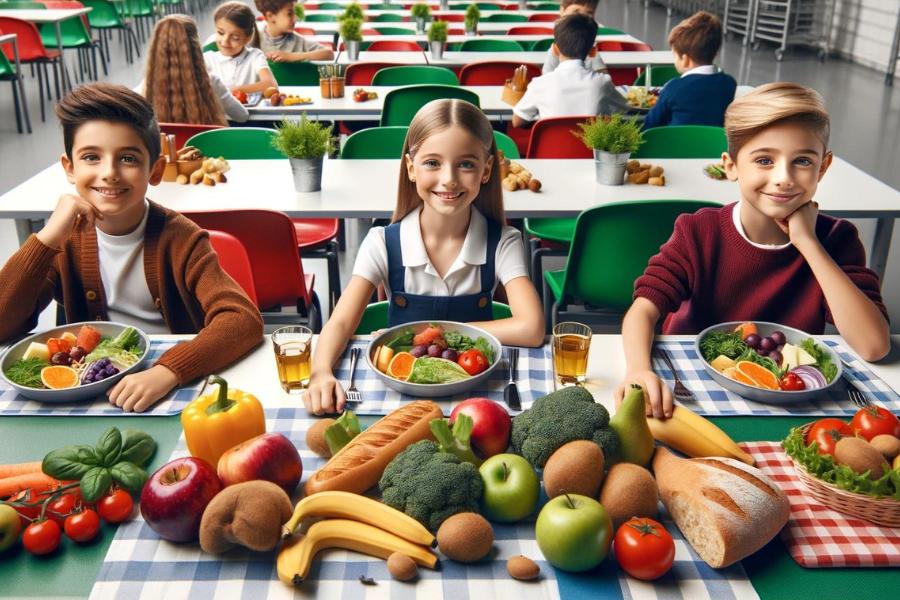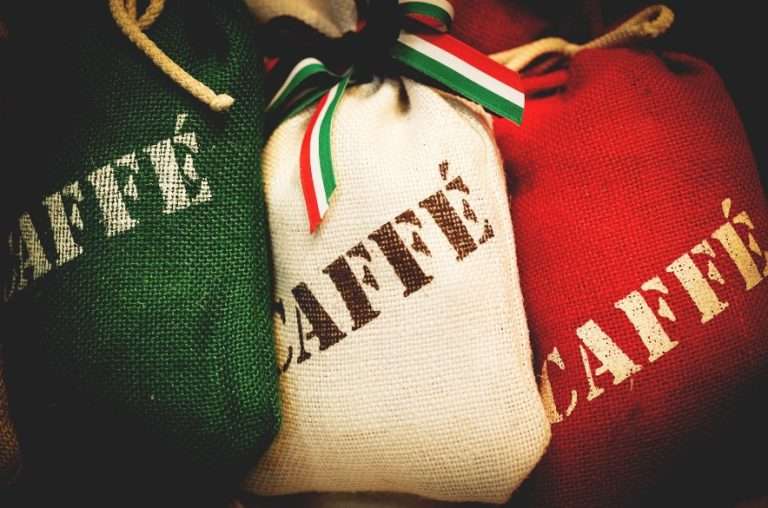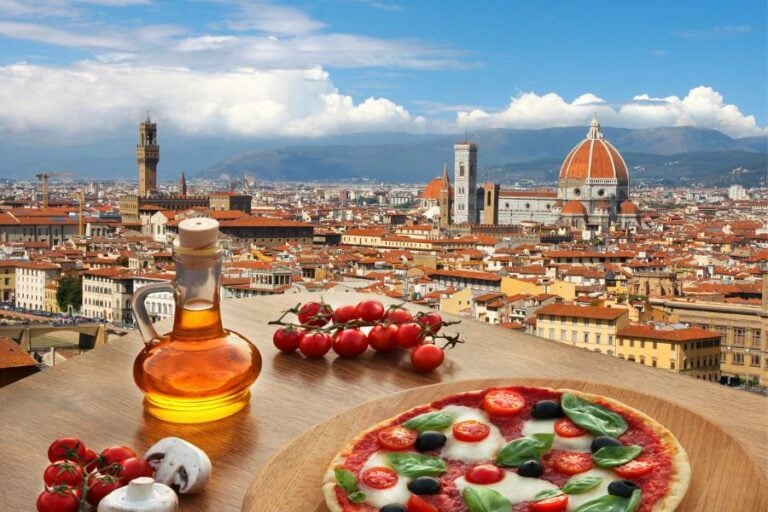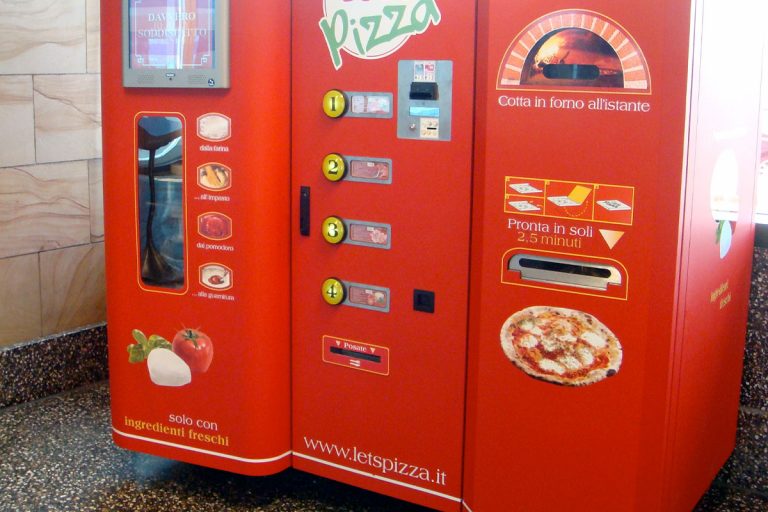School Lunch in Italy: What Italian Kids Eat Midday

Ciao, food enthusiasts! We’ll explore what sets the Italian school lunch apart from the rest by diving into the world of what Italian kids eat for lunch while at school.
Join us as we uncover the unique elements that make these midday meals a true reflection of Italy’s rich culinary heritage.
Overview of Italian School Lunches
Italian public school lunches reflect the country’s commitment to healthy eating habits through adherence to the Mediterranean diet. The Ministry of Health and Italian law work in tandem to shape a nutritional framework that promotes children’s well-being.
Elementary and primary schools serve lunch as an integral part of the day, focusing on the inclusion of fresh, seasonal ingredients.

These meals are prepared in central kitchens and emphasize variety and balance, hallmarks of the Mediterranean diet, which includes the following components:
- A high presence of plant-based foods (fruits, vegetables, legumes)
- Moderate consumption of dairy, mainly cheese and yogurt
- Fish and poultry consumed in low to moderate amounts
- Limited intake of red meat
Education on nutrition starts early to foster healthy eating habits.
| Food Type | Description |
|---|---|
| Whole Grains | Often found in pasta, bread, and rice integral to Italian cuisine |
| Fresh Fruit | Fruit for dessert is common in Italy, promoting natural sugars and fiber |
| Vegetables | Included in every meal for vitamins and minerals |
| Olive Oil | The main source of added fat, rich in monounsaturated fatty acids |
The approach to lunch in Italian schools extends beyond nutrition, aiming to educate children about food sources, preparation, and the cultural significance of meals, which is deeply interwoven with Italian heritage.
Hydration is also vital, with children encouraged to drink water rather than sugary drinks.
Consistently, Italian children are introduced to a wide array of flavors and textures, supporting a well-rounded palate and setting the foundation for lifelong healthy dietary preferences.
Nutritional Guidelines and Legal Framework

In Italy, the nutritional quality of school lunches is underpinned by a robust legal framework and specific school nutrition guidelines from the Ministry of Health.
These ensure that meals provided in schools comply with Italian law and promote organic food consumption where possible.
Ministry of Health Standards
The Ministry of Health in Italy sets comprehensive standards for school meals to ensure that children receive nutritionally balanced diets that are in line with Italian dietary traditions.
The guidelines advocate the inclusion of organic products where feasible, aiming to provide meals that are both healthful and environmentally conscious.
The standards enforce a quota of organic food to be integrated gradually into school lunches, reflecting Italy’s commitment to sustainable agriculture.
Hungry for the specifics? Dive into the official document by the Italian Ministry of Health, detailing standards and guidelines for school lunches in Italy (PDF, in Italian).
Italian Educational System Requirements
School canteens are mandated to offer a variety of foods across the week, including a balance of proteins, carbohydrates, and fats, with a strong emphasis on fresh fruit and vegetables.
Menus are often rotated four times weekly to ensure a diverse intake of nutrients, and meals are crafted to avoid excessive fats and sugars, embodying Italy’s holistic approach to health and nutrition in education.
Typical Foods in School Kitchens

School lunches look like a reflection of Italy’s rich culinary heritage, emphasizing fresh, high-quality ingredients and a harmonious balance of flavors.
These meals often feature a variety of main courses, vegetable side dishes, and fruits and desserts, providing a wholesome experience for students.
Main Courses
- Pasta: A staple of Italian cuisine, pasta is served in schools with various sauces, often tomato-based, and sometimes accompanied by meat or vegetables.
- Pizza: Traditional pizzas with a simple topping of tomato sauce and cheese, sometimes featuring vegetables or ham.
- Lasagna: Layers of pasta with cheese, meat sauce (like Bolognese), or vegetables, baked to perfection.
- Rice: Arborio or other Italian rice varieties are used to make dishes like risotto, often enriched with seasonal vegetables or meat.
Vegetable Side Dishes
- Salads: Fresh mixed greens, often with slices of tomato and chunks of cucumber, dressed with olive oil and balsamic vinegar.
- Cooked Vegetables: Seasonal vegetables such as zucchini, eggplants, or bell peppers, either grilled or lightly sautéed.
Fruits and Desserts
- Fresh Fruit is a common end-to-meal choice, including seasonal fruits like apples, oranges, or grapes.
- Dessert: Simple desserts like a piece of fruit tart or gelato may be offered.
Meal Quality and Ingredients

Italian school lunches are renowned for their high-quality ingredients and adherence to the Mediterranean diet.
Meals often feature a variety of fresh fruits and vegetables and incorporate certified organic products to ensure sustainability and health.
Use of Organic Products
Italian schools prioritize the use of certified organic ingredients in their lunch programs. To uphold this standard, they ensure that items such as pasta, rice, and even olive oil have official organic certification, reflecting a commitment to sustainable food practices within educational environments.
Freshness and Seasonality
The principle of freshness is central to the Italian school menu, which frequently consists of fresh fruit and vegetables that embrace the seasonality of produce.
This practice not only supports local agriculture but also provides students with the optimal nutritional benefits that come from consuming produce at its peak.
Cultural and Regional Variations
Italian school lunches reflect the country’s diverse culinary traditions, emphasizing regional dishes and local ingredients.
Each region takes pride in its unique specialties, with schools often incorporating organic and locally produced foods like Parmigiano cheese.
Dietary needs, including allergies, intolerances, and religious restrictions, are increasingly being carefully and attentively catered to.
Local Specialties
In the Lazio region, where Rome is located, school lunches might feature classic Roman dishes such as pasta with a simple tomato sauce sprinkled with parmesan cheese, showcasing the region’s culinary heritage.
Organic food is also a growing trend in Italian schools, with a push towards using locally sourced and seasonal products to provide healthier options and education about regional food cultures. For example:
- Lazio Region: Pasta with tomato sauce and Parmigiano cheese.
- Northern Italy: Risotto or polenta-based dishes.
Catering to Dietary Needs
Italians are becoming more attentive to dietary restrictions caused by allergies, intolerances, and religious restrictions in schools.
Menus are adapted to remove common allergens or to respect dietary laws, ensuring inclusivity and safety. Here’s how some schools are addressing these needs:
- Allergies/Intolerances: Offering gluten-free pasta or dairy-free alternatives
- Religious Restrictions: Serving meals suitable for various religious practices, such as pork-free options
Differences from Other Countries
Italian school lunches stand out for their incorporation of fresh, local ingredients and adherence to the Mediterranean diet, presenting notable contrasts to school lunch programs in regions like the USA and other parts of Europe, Asia, and beyond.
Italian vs American School Lunches

In Italy, school lunches typically include a variety of fresh produce, high-quality grains, and protein sources, reflecting the country’s culinary traditions. A strong emphasis is placed on the use of seasonal ingredients and balanced meals.
For instance, students may enjoy a pasta dish with a tomato-based sauce, a side of vegetables, fruit, and perhaps a slice of cheese or meat as the main protein.
On the other hand, American school lunches often feature processed foods high in sugars and saturated fats. It is not uncommon for American students to have options such as pizza, hamburgers, fried chicken, and French fries, accompanied by sweetened beverages, which might lead to obesity.
Mediterranean Diet Contrast with Other Regions

The Mediterranean diet, which forms the basis of Italian school lunches, is marked by abundant use of olive oil, whole grains, fresh fruit, and vegetables, making it distinct from school lunches found in other regions.
Countries such as France and Japan also take pride in their school lunches, focusing on nutritional balance and the use of local, seasonal foods.
For example, French school meals are a reflection of the country’s gastronomic culture, featuring courses such as a starter, a protein-rich main dish, a side of vegetables, cheese, and dessert.
Implementation of School Lunch Programs

The successful implementation of school lunch programs in Italy is a product of meticulous daily menu planning and strategic budget and funding allocation.
The Italian approach demonstrates an investment in children’s health and education through carefully crafted school meals that balance nutrition with culinary tradition.
Daily Menu Planning
The ministerial guidelines provide a general overview of the frequency of consumption for different foods and food groups during the school week across all types of schools. Specifically, the standard school menu might include:
| Food Type | How Often it is Served |
|---|---|
| Fruit | One portion every day |
| Vegetables | One portion every day |
| Cereals (pasta, rice, barley, corn, etc.) | One portion every day |
| Bread | One time a week |
| Legumes | 1-2 times a week |
| Potatoes | 0-1 times a week |
| Meat | 1-2 times a week |
| Fish | 1-2 times a week |
| Egg | 1 per week |
| Cheese | Two times a month |
| Cold cuts | One time a week |
The composition of the nursery school menu (ages three to six), and the primary and secondary school menu might follow this illustrative example (which, we emphasize, also depends on the seasonal availability of ingredients):
- Main Course: Pasta (with tomatoes, legumes, vegetables); rice (with tomatoes, legumes, vegetables); soup (legumes and vegetables); pizza.
- Second Course: Vegetable frittata; meat; fish; salads; cheese or dairy products.
- Vegetable Side Dish: Vegetables or greens are prepared in various recipes, including “enticing” ones (for example, vegetable meatballs).
Additionally, every day includes a portion of bread (usually a white or whole grain roll) and a portion of fresh fruit (some days pre-cut – packaged according to specific requirements and standards – or fresh, especially bananas, oranges, clementines, and apples).
This menu structure reflects a balanced approach to nutrition, ensuring that many Italian children receive a variety of foods that contribute to their overall health and well-being.
Budget and Funding
The budget allocated for school meals plays a crucial role in sustaining the quality of lunch programs. Funding is typically sourced from governmental and regional agencies and carefully distributed to public schools across Italy.
Investments are made to uphold high nutritional standards while fostering the cultural aspect of Italian food.
Schools work within this budget to procure ingredients, manage staff costs, and maintain kitchen facilities, always aiming to deliver meals that support the growth and development of students.
- Government Subsidies: Significant contributions from government bodies ensure basic nutritional needs are met.
- Local Investments: Additional funding from local authorities can enhance meal quality and variety.
- Parental Contributions: A sliding scale of fees may apply depending on a family’s income, assisting with the overall funding pool.
Dining Experience and Environment

In Italian school lunches, the emphasis on creating a nurturing dining environment is pivotal.
It revolves around not just the food, but also the setting in which students consume their meals and the educational opportunities mealtime can present.
School Cafeteria Setup
Italian school cafeterias do create a family dining atmosphere with communal tables, bread baskets, ceramic plates, cloth napkins, and clear glasses, emphasizing community and proper dining etiquette. This setting encourages sustainable meal consumption and teaches respect.
Educational Aspect of Lunchtime
Lunchtime in Italian schools is not merely a break for refueling, but a period woven with educational threads.
Educators and kitchen staff engage with students to impart knowledge about healthy eating habits, local cuisine, and the importance of slow food principles.
They often discuss the nutritional value of the foods served, the origin of the ingredients, and how meals contribute to students’ health. This involvement turns the lunch hour into an interactive session that extends learning beyond the conventional classroom boundaries.
Food Education and Eating Habits

Educational institutions in Italy strongly emphasize healthy eating habits to ensure that students maintain their health and have enough energy throughout the school day.
The traditional approach involves the food provided and the education around making informed food choices.
During the lunch break, it is common for Italian schools to offer a well-balanced meal, which typically includes a variety of food groups. The goal is to discourage the consumption of junk food and fast food, particularly among younger students who are developing their dietary preferences.
In addition to lunch, a mid-morning snack is often provided, highlighting the Italian commitment to maintaining regular eating schedules and avoiding excessive calorie intake.
These Italian snacks tend to consist of fresh fruits or whole-grain products, avoiding processed options that could contribute to becoming overweight.
Educators in Italy strive to instill healthy habits early on. They teach students about the importance of a varied diet that includes fruits, vegetables, whole grains, and lean proteins.
Realizing the value of these habits has the potential to reduce issues prevalent in many societies where processed fast food is commonplace.
Frequently Asked Questions
In Italian schools, lunch is an integral part of the day, reflecting the country’s culinary heritage. The following are common queries pertaining to Italian school lunches.
Do students in Italy typically eat lunch in school or go home?
Students in Italy usually eat in school. However, because the Italian school day often ends earlier than the American school day, some students may go home to eat lunch with their families.
Suggested Read: How to Say Eat in Italian: Your Guide to Mangiare
What are the common items found on an Italian school lunch menu?
Italian school lunch menus often feature a variety of pasta dishes, a selection of meats, fish, cheeses, fresh fruits, vegetables, and bread.
This MIT OpenCourseWare page illustrates the emphasis on incorporating elements of the Mediterranean diet into meals, all while learning basic Italian!
How do Italian school lunches compare to American school lunches?
Compared to American school lunches, which can vary widely but often include options such as pizza, hamburgers, and hot dogs, Italian lunches typically provide more courses, including a portion of pasta or soup, a second course with a side dish, and fruit or dessert.
School lunches in Italy prioritize fresh, locally sourced ingredients and traditionally spend more time on lunch breaks, as elaborated on this Brookings Institution page that discusses the impact of quality lunches on academic performance.
What are some traditional Italian recipes served for school lunch?
Traditional Italian recipes served for school lunch might include pasta with tomato sauce, risotto, Margherita pizza, frittata with seasonal vegetables, or a Caprese salad. These dishes focus on fresh, seasonal ingredients, as is customary in Italian cuisine.
Suggested Read: 110 Fun Facts About Pizza: A Slice of Global Culture
Which countries are known for having the healthiest school lunches?
Countries like Italy, France, and Japan are known for having some of the healthiest school lunches. These countries value fresh, nutritious ingredients, balanced meals, and healthy eating habits from a young age.
What factors contribute to the quality of school lunches across different countries?
Government policies, cultural values related to food and nutrition, economic investment in school meal programs, and the availability of fresh, local ingredients contribute to the quality of school lunches.
Initiatives and collaborations with nutritionists and chefs ensure that the meals are both healthy and appetizing for students.






